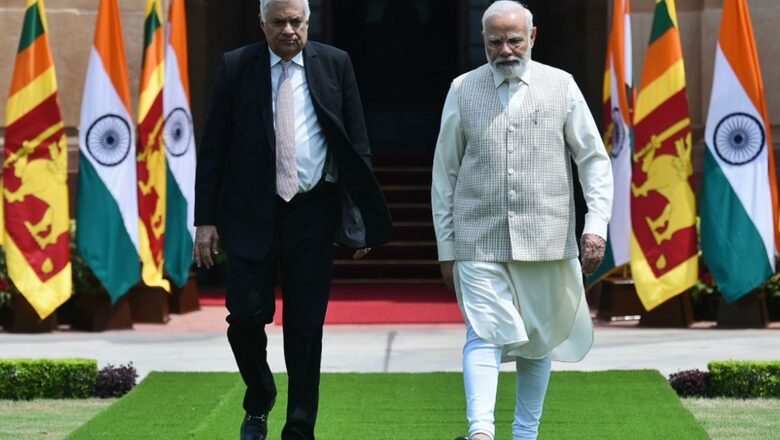
views
Back in 2020, Indian Prime Minister Narendra Modi reaffirmed that Sri Lanka will always be a priority under its Neighbourhood First Policy. Not garrulous, but through action as well, India aided Sri Lanka since the Covid pandemic in various ways — financial aid, line of credit, and diverting 270,000 metric tonnes of diesel and petrol — to name a few. It was at the invitation of PM Modi when the President of Sri Lanka, Ranil Wickremesinghe, visited India on July 21, 2023.
The visit by Sri Lankan President witnessed a diverse set of engagements, ranging from connectivity that includes air, maritime, energy, power, trade, economic, financial, and people to people. Further, five MOUs were signed ranging from animal husbandry and renewable energy to UPI application acceptance and solar power projects. But why Sri Lanka plays an important role in India’s Neighbourhood First Policy? Let’s decode this.
India’s Neighbourhood First Policy aims to improve its relationship with immediate neighbours. India and Sri Lanka’s relationship is not new but has remained in place for more than 2,500 years. Not just economically, but both sides have built upon a legacy of intellectual, cultural, religious and linguistic interactions.
Sri Lanka as a priority is not a new addition to India’s foreign policy. The bilateral relations between the two range from the highest political level to growing trade and investment to cooperation in the fields of development to education, culture and defence, as well as a broad understanding of major issues of geopolitical interest.
Although China’s influence on Sri Lanka and its projects seems competitive for India, the relations have stood the test. Last year when Lanka’s economy went into a tailspin, it was India who came first and supported the growth of the country. Apart from years of bilateral relations, Sri Lanka’s positioning in the South Asian region is strategic. Even before India became independent, colonisers understood the “strategic importance” of the region.
Britain recognised Sri Lanka’s strategic importance for the security of both British India and the Indian Ocean, and they built a strong naval base on the island’s eastern coast at Trincomalee. Further, this island republic is situated between the main shipping lanes connecting Europe with East Asia and the oil tanker routes connecting the Gulf oil-producing nations with China, Japan, and other Pacific nations.
Since the United States transfers naval strength from the Pacific Ocean to the Indian Ocean and the Gulf over the same sea channels, it is significant from a military standpoint. India, for own its security in terms of Indian Ocean strategy and partner networking for forming an Indian Ocean Rim Community, cannot expect a hostile Sri Lanka.
It is paramount to the Indian Navy because while switching naval fleets from the Bay of Bengal to the Arabian Sea and vice versa, the ships pass via Sri Lanka. China’s investment in the Port of Colombo and the Port of Hambantota has become a red flag for both the US and Indian naval fleets. Apart from the geopolitical level, any political turmoil can pose a security challenge for India. For instance, during the economic crisis, many Sri Lankan Tamils illegally migrated to Tamil Nadu and other southern states of India.
Here, it is important to note that in the three-decade civil war in Sri Lanka, India also bore the brunt. The Ministry of Home Affairs in the 2021-22 annual report informed that 3,04,269 Sri Lankan refugees migrated to India. The data was collected for the duration from July 1983 to August 2012. On the refugee camps, over 108 camps were established in Tamil Nadu and 54 in Odisha. Since then, India has provided Rs 1,226 crore for the relief and accommodation of refugees from July 1983 to March 31, 2022.
The civil war not only resulted in the death of Sri Lankan soldiers but Indian Peacekeeping Soldiers also sacrificed their lives. India and Sri Lanka inked a pact in 1987 to put an end to the civil conflict. The main goal of the agreement was to put an end to the conflict between the Sri Lankan militants and the militant Liberation Tigers of Tamil Eelam (LTTE).
The civil war in Sri Lanka put India’s interests and integrity in danger. There were two possible explanations for this hazard. First, it would have been a significant threat to India’s security if other nations had attempted to control Sri Lanka. Second, the fundamental goal of the LTTE was to create a Tamil state that would have included all Tamils, which constituted a challenge to India’s integrity. India started two operations in the country, Operation Pawan and Operation Poomalai.
Thus, it is evident that situations in Sri Lanka have a direct impact on India that have geopolitical, financial, economic, and security challenges for our country.
Views expressed in the above piece are personal and solely that of the author. They do not necessarily reflect News18’s views.















Comments
0 comment